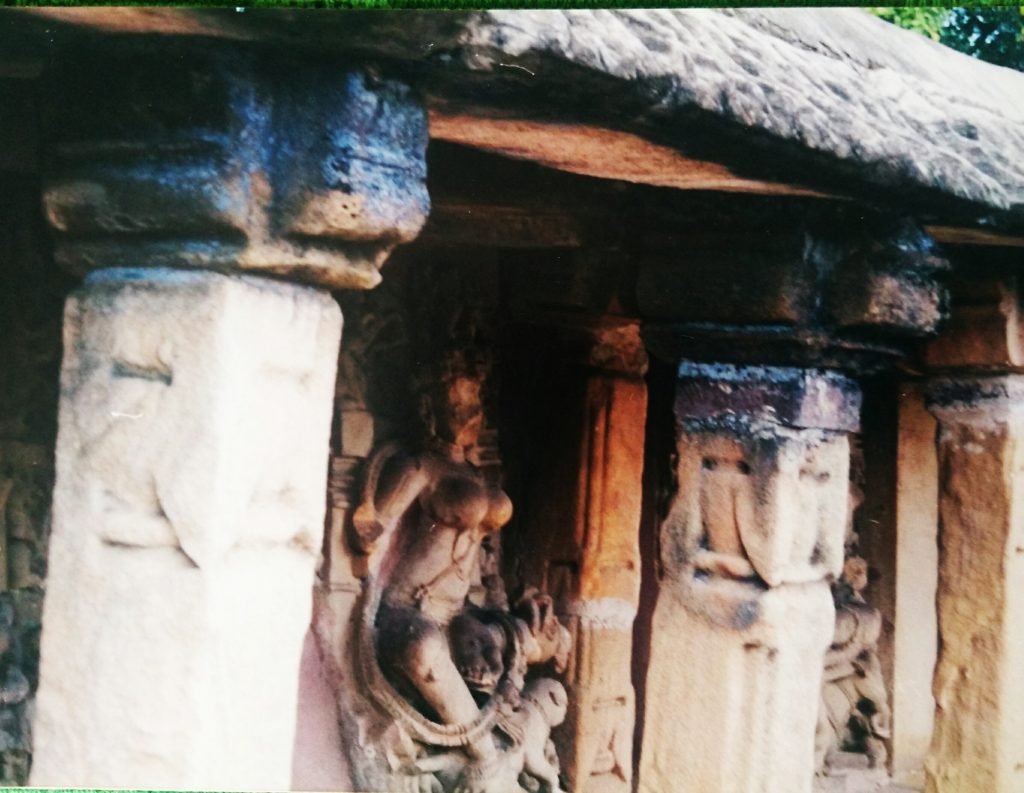
Travel: Chausat Yogini temple in Jabalpur

It was the stuff of high adventure: stumbling on a small, mysterious but beautiful temple, the Chausat Yogini mandir, tucked into a fold of a hill up above the Narmada river.
When you are far down in the swirling gorge of the mighty Narmada river you catch your first glimpse of it. More than a hundred feet above, sunlight glints off the blackened stone of a tiered steeple and chatris. Your imagination is immediately caught by this place, the Chausat Yogini mandir.
Like all worthwhile things, the temple is not accessed easily. In the fork where the Bawanganga joins the Narmada, the rock formation rises to a small round hillock.
Just ahead of the steps that lead down to where the Marble Rocks stand sentinel over the jade-green Narmada, ancient and worn stone steps lead up to a plateau where stands one of the most compact temples ever, with intricate carvings all over the roof. It is only 130 feet in diameter, of a cloister shape with dozens of separate shrines.

This Chausat Yogini (the temple of the 64 yoginis, incarnations of Shakti) is a 10th century shrine, the personal temple of Rani Durgavati from the Kalachuri dynasty that once ruled these parts of central India. Right in front of the shrine complex is a heavy stone slab, under which, if legend be true, should lie the tunnel that led from Rani Durgavati’s chambers in the Madan Mahal fort palace, to the temple.
However the palace is now rubble and it seems unlikely that much of the tunnel still exists. The extant walkway that rings the temple affords charming views of the jungles of Maha Kaushal on one side and a bend in the Narmada on the other.

The temple is unique for the outer circular gallery built for the bloody ritual sacrifices dedicated to the Goddess, which were performed here in past centuries, and for the idol of Shiva and Parvati riding the Nandi in the main sanctum. Tales also suggest that Shiva decided to reside here eventually, due to a particularly devoted ascetic.
From the 9th to at least the 13th century, there was an active cult of Dakinis, usually called yoginis, female practictioners of tantra and yoga, warrior sorceresses who traversed the skies and devoured human flesh, and were ritually summoned by devotees who wanted to harness their powers. History indicates that dakini rituals were practised well into the 16th century, but soon the cult diminished and its temples were abandoned.
However even today, offerings are often left at the feet of the images of the sacred feminine. At least nine yogini temples have been discovered so far. The best known are the ones in Orissa, Uttar Pradesh and Tamil Nadu as well as this one in Madhya Pradesh.
These shrines were centres for Tantric practices, the ultimate goal of which was the acquisition of supernatural powers. The practitioner aspired to control the body and mind, bring rain and otherwise regulate the elements, obtain wealth, heal the sick … and perhaps also acquire destructive powers. The term yogini is also a respectful acknowledgement of female spiritual teachersi n both Hindusim and Buddhism.
Religious lore has it that this temple is dedicated to Goddess Durga and her 64 attendants. There are eight major forms of Devi, the Ashta Matrikas, the eight mothers. Each of these has eight attendants and thus we arrive at the number 64, all of them representatations of the feminine divinity.

In Yogini worship, the Tantrik symbol is a chakra with 64 spokes in the wheel and each spoke represents one yogini, one form of Shakti. The Yoginis are Dakinis, feminine demons, but attendants of Shakti. Each yogini is a voluptuous woman wearing apparel held around her hips with an ornate girdle. Besides the belt, she wears the other seven symbolic ornaments: bracelets, armlets,
anklets, earrings, necklace, garland and headdress.
Some are warriors or huntresses with bows and arrows, others balance on a pair of wheels, or play a drum. Most have two arms but a few have four. The mount of the dakini includes animals such as parrots, turtles and scorpions. Several of the Dakinis have animal faces, for example those of the horse, lion and hare are represented. One yogini is Ganeshani, a feminine form of Ganesha and shown standing, with the head of an elephant.
Another is Shri Aingini. A small-sized Ganesh stands at her left leg. However far from all the statues are intact: marauding armies invaded this place in 1564 so many of the yoginis in this Chausat Yogini mandir are decapitated and some are in stages of repair. In the centre of the complex stands the Gauri Shankara mandir.

The priest beckons you inside the sanctum sanctorum and offers `prasad` right next to the jet-black
main idol, something we do not do in the temples of south India. And as you make your way down with many a backward glance, you suddenly notice strange inscriptions to one side of the stone steps.
More mystery. It is of a piece with the utterly enigmatic ambience of the Chausat Yogini mandir.
How to get there: The Chausat Yogini temple is about 25 km from Jabalpur, at Beraghat. Jabalpur
has an airport (Dumna) as well as being a major rail hub. On the Mumbai-Howrah via Allahabad main line, all mail, express and passenger trains halt here.
By Road: Buses, tempos and taxis are available from Jabalpur. We recommend the last, though.
Best Season: October to May.
This piece ran in DECCAN HERALD of 2 Feb 2004.
My related MP stories: